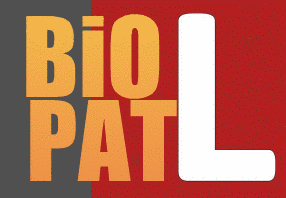
Bio Process Analytical Technology (BIOPAT) Laboratory
Phone: +91-361-2582226 (O)
Email : senthilkumar[AT]iitg.ac.in
Research Area
Biopolymers
Hyaluronic acid
Hyaluronic acid (HA) is a linear, non-sulphated, anionic muco-heteropolysaccharide made of repetitive monomer units of UDP N-Acetyl glucosamine (UDP-GlcNAc) and UDP D-Glucuronic acid (UDP-GlcUA) alternately. The colossal significance of HA finds its application in the areas of medicine and cosmetics, such as drug delivery, osteoarthritis and ophthalmology surgery, wound healing, tissue engineering, moisturizer, dermal filler, etc. The molecular weight of HA is a critical quality attribute that determines its usage in various end applications and demands attention to achieve the consistent quality of the final product.
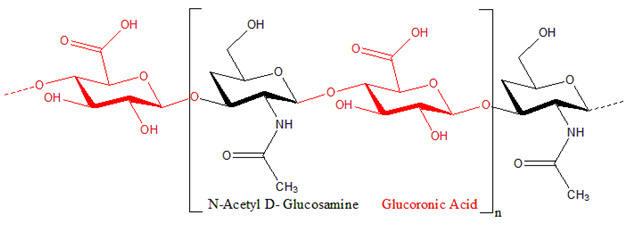
Molecular structure of Hyaluronic acid
The complexity in the HA production process has more to be dealt with the process engineering manoeuvres than the genetic engineering approaches. Our lab designed different process strategies and successfully utilized PAT tools on monitoring and control of various critical process parameters (CPPs) influencing HA titer and molecular weight. Application of recombinant GRAS organisms as host is in progress to achieve high molecular HA production.
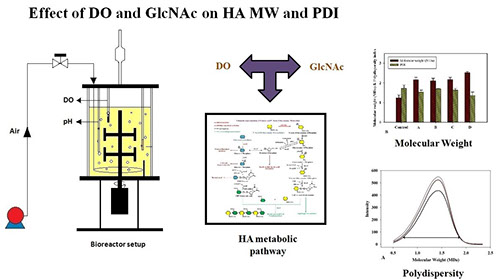
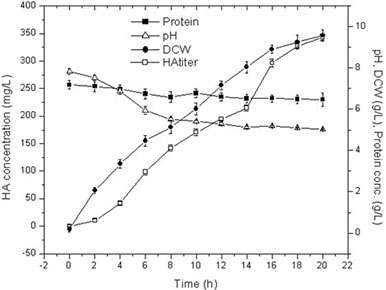
Effect of Dissolved Oxygen and GlcNAc on HA molecular weight and polydispersity index
Dynamic profiles of DCW ( g L−1), pH, total protein concentration ( g L−1), and hyaluronic acid titer ( mg L−1) during batch cultivation of S. thermophilus under global optimal conditions.
HA is commercially produced by extraction from rooster comb and by fermentation of natural and potentially pathogenic microbial producer Streptococcus zooepidemicus which is known to cause infections in the respiratory tract. Presently, our group is actively involved in metabolic engineering of GRAS organism as a host to achieve high molecular weight and mono-disperse HA synthesis.
D (–) lactic acid
D (–) lactic acid (DLA) is a versatile organic acid molecule, extensively employed in the production of thermostable biodegradable polymer, polylactic acid (PLA). Optically pure DLA is a prerequisite for the production of PLA with improved mechanical and thermal properties expanding its scope in food packaging applications. Microbial fermentation process is an attractive techno-economic strategy to produce optically pure DLA compared to racemic mixture yielding expensive chemical synthesis. However, the choice of raw feedstock and its preprocessing requirements for microbial fermentation decides the fate of the final product cost. Our team is actively pursuing designed biomass approach (DBA) to elucidate right choice of raw feedstocks, preprocessing strategies and elite strain targeting enhance DLA titer and its productivity.
The global demand for lactic acid (LA) derivatives, requires feedstocks that are economically viable and environmentally sustainable. Exploration of low-cost feedstocks and the right choice of process engineering strategies could markedly reduce the DLA production cost. We examined Kodo millet bran residue (KMBR) and agroforestry/industry biomass as an alternative substrate. Estimation of kinetic parameters by mathematical modelling of DLA fermentation experimental data guided us for the right choice of feeding strategies.
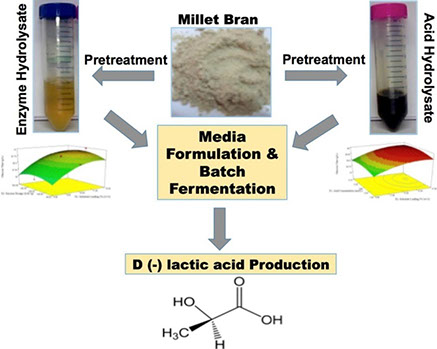
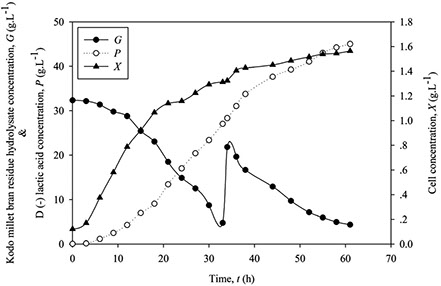
Schematic representation of enzyme and acid hydrolysis of kodo millet (Paspalum scrobiculatum) bran residue for DLA production
Time profiles of concentrations of cell, KMBRH, DLA in fed-batch (pulse feeding)
Cassava fibrous waste (CFW) is one of the viable feedstock options for DLA production. The processability of CFW and its enzymatic hydrolysis was improved by a novice process intensification attempt of integrating a polymer matrix with enzyme i.e. using a tailor-made electrospun nanofibers and its application in immobilization of α – amylase enzyme. Fermentation studies were performed using elite Lactic acid bacteria (LAB) possessing feedstock inhibition capability, which was achieved by adopting process intensification step involving designed biomass approach (DBA) and Inhibition kinetic modelling. This research outcome offers the knowledge of kinetic parameters, its transformation into operational parameters, which would be helpful for sustainable synthesis of DLA. Kinetic investigation reported in this study is a novice attempt in enumerating the valorisation potential of CFW for the synthesis of DLA at commercial scale in near future.
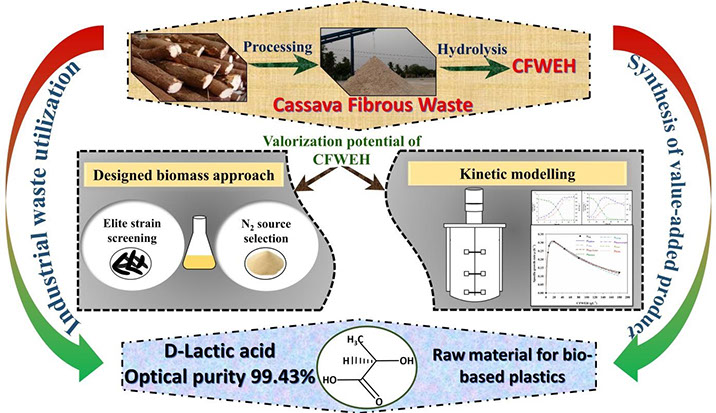
Schematic representation of production of DLA from cassava fibrous waste.
Metabolic engineering of LAB strains for the effective valorisation of waste feedstock to value-added chemical (DLA) is in progress. Our group is extensively involved in design and development of an integrated bioprocess system facilitating DLA production, purification and recovery.
Poly-3-hydroxybutyrate
Poly-3-hydroxybutyrate (PHB) is a storage compound produced by microbial cells that could be utilized during starvation. Much attention has been attained as it is an attractive alternative to petrochemical plastics, owing to its biodegradability, thermoplasticity, hydrophobicity, and mechanical properties. Moreover, with its inert properties, PHB encompasses wide applications in the biomedical and pharmaceutical sectors. The microbial platform is under the limelight for PHB synthesis because of its high growth rate and yield. The cost of raw material impedes fermentative (PHB) production at an industrial scale. We successfully tailored B. megaterium to avail waste as a feedstock (millet bran and rapeseed meal hydrolysates) and achieved an efficient PHB titer.
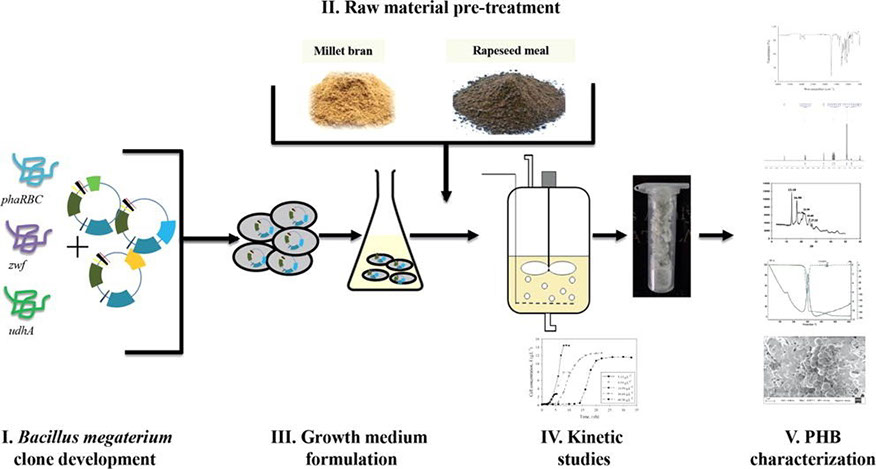
Pre- Treatment of Raw Materials
Wax ester
Wax ester (WE) is a high-value neutral lipid formed by the conjugation of fatty acid and fatty alcohol. It has numerous applications such as high-grade lubricants, wound healing, bio-surfactants, gum-bases, personal care products, biodiesel production, etc. Depending on the carbon length and the degree of unsaturation, its physical and chemical properties differ and hence the end application is disparate. The global ban and high cost of production of animal and plant waxes were the stumbling blocks for its commercialization. Alternate methods such as chemical synthesis and immobilized lipase esterification required the supplementation of precursors. Hence we have chosen a microbial platform for its production. . In silico metabolic engineering of the host organism to identify the genes that would increase the flux towards WE production rather than its competing pathways is in progress. Bioprocess optimization studies are underway utilizing recombinant WE producing strain to achieve high productivity.

Bacteria, the viable option for WE production
Copyright @ BioPAT LAB, IIT Guwahati.